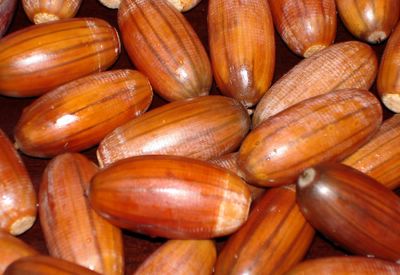Collecting Acorns
When I was in third grade it became fashionable among the girls in my class to collect acorns that fell from a large oak tree that grew on our school playground. Most girls had special places to hide their stash outside, but I decided that it would be much safer to keep mine in my pencil box inside my desk. This kept them quite safe from squirrels and the other girls, but one predator slipped past my defenses--acorn weevils! You can imagine my surprise when I opened the box one day to find the little green worms munching through my precious acorns. And you can imagine my teacher's feelings as she made me stay in from recess to get rid of the worms and sanitize my entire desk.
But I don't think I learned my lesson.

We were walking home from dinner with a friend the other night when I noticed a bunch of acorns lying on the ground between three tall trees. Much to our friend and Sweet Husband's amusement, I decided to gather some "to use for something." I thought I'd bring them home, maybe put them in a bowl on my coffee table for some free fall decoration, and, of course, watch them scrupulously for the first sign of anything resembling a bug.
But I came home and did some research, and it turns out there is a lot about acorns that I didn't know. For example, acorns are edible. Before the mass production of corn Native Americans would collect and hull acorns, and grind the nut inside to make a flour-like substance. In order to make the acorn meal palatable it must be leached of bitter tasting tannins, but that's as simple as rinsing it with water until the water runs clear. Once rinsed and dried, acorn meal can be substituted for flour or corn meal in bread, cakes, tortillas, or whatever else strikes your fancy.
I also found out that oak trees which grow from acorns, while slow to start, live for hundreds and hundreds of years. I'm a big fan of Elizabeth I (very important Queen of England and all around kick-ass lady for those of you who don't know) so when I was in England about four years ago, I made a point to visit Hatfield House which was her childhood home. On the grounds at Hatfield, there is an oak tree that is supposedly the tree Elizabeth was standing by when she got the news that she was Queen in 1558. I followed the map and found the tree, but--despite the trees gnarled and old appearance--I was just a little dubious that a tree could really live for 500 years. But, as it was an oak tree, it's entirely possible.
In my search, I also came across a few articles about planting acorns, which I decided would be the best use of mine. The first step was to figure out what kind of acorns I had, so I went back to the trees I collected the acorns from. Based on the leaf shape and unique white backside of the leaf, I've decided that the tree is a Swamp White Oak, which is fairly common in the Midwest.
Next, I did a "float test". I put the acorns in a bowl of water for 24 hours, and threw away the two acorns that floated. Acorns that float have an air pocket inside of them created by bugs eating away the nut inside--good-bye acorn weevils!
From there, many of the sources I've found disagree on what the best next step is. A nice poster on GardenWeb told me to "be a squirrel" and that seems to be the general thread that runs through all the methods I found. Some places say to plant the acorns where you want them to grow, about two inches in the ground, with some kind of covering to protect them from squirrels. You can also plant them in pots and then sink the pots into the ground, again protecting from squirrels. Another, very comprehensive site said to put them in a loosely closed plastic bag with a bit of peat and store them in the fridge over winter, keeping them just barely damp. The acorns can then be planted in paper cups in mid-April and gradually hardened off and transferred to bigger containers, until you plant them in the ground either the next fall or spring.
I decided to make it a bit of an experiment and try all three methods. I've planted 15 acorns out and about in the yard surrounding our house, and 15 acorns in our previously empty grow box. I'm diverging from the directions a bit on the grow box because I don't think I could dig a big enough hole to put it into the ground. Some sources say this will be ok, others say the lack of insulation can be harmful. I guess we'll find out! I've also stored 15 acorns in my (ever fuller) refridgerator for planting in the spring.
Right now I'm just interested in the process, I don't have plans for the resulting trees. "It takes faith to plant an acorn," and I have faith that if they grow I'll find something worthwhile to do with them. Maybe I'll send one to my old teacher.





0 Comments:
Post a Comment
<< Home